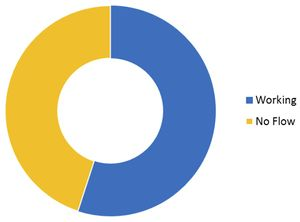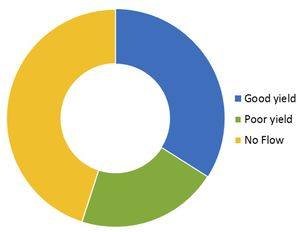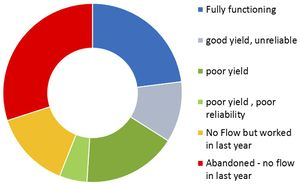OR/17/029 Survey 1 Results, Uganda
| Owor M, MacDonald A M, Bonsor H C, Okullo J, Katusiime F, Alupo G, Berochan G, Tumusiime C, Lapworth D, Whaley L, Lark R M. 2017. UPGro Hidden Crisis Research Consortium — Survey 1 Country Report–Uganda . British Geological Survey Internal Report, OR/17/029. |
 |
The results of Survey 1 in Uganda are summarised below.
| Functionality performance level | % pass |
| Basic – working (yes/no) | 55 |
| Snapshot – provides sufficient yield (10 L/min) | 34 |
| Functionality performance – sufficient yield and reliability (<30 days downtime in last year) |
23 |
| Functionality including water quality – passes WHO TTC and inorganic parameters | 18 |
The ‘Basic’ and ‘Snapshot’ assessments reflect the requirements of national survey assessments, whilst the more performance-focused definitions are more relevant to local or regional surveys looking to track the functionality of individual water points or programmes through time.
The results of the basic survey (55%) are lower than the National functionality of rural water supply (86%). The difference is likely to be due to our different sampling methodology, where we randomly sample from all boreholes equipped with a handpump. The more comprehensive assessments of functionality performance which include yield and reliability are considerably lower.
Water quality is generally considered a service issue rather than strictly water point functionality. A breakdown of district results is shown in Appendix 3.
Basic functionality

Snapshot functionality

Functionality performance

Functionality performance – including water quality
Water quality issues (%) | |||||
None |
TTC only | Inorganic only | both | ||
| Fully functioning | 17.6 |
2.6 |
1.6 |
1.0 | |
| Good yield, unreliable | 6.2 |
3.1 |
0 |
1.6 | |
| Poor yield | 12.8 |
3.1 |
0 |
0.9 | |
| Poor yield, poor reliability | 3.5 |
1.4 |
0 |
0 | |
| No flow but worked in last year | 14 |
||||
| No flow abandoned | 30.6 | ||||
Some HPB’s are shown to have Thermo-tolerant coliforms (TTC) in excess of the WHO drinking water standard. TTC’s are a bacterial indicator of sanitary quality of water. We used the strict WHO standard of a failure being any measured TTC in the water, rather than a risk based approach which would prioritise higher concentrations of TTCs.
A few other HPB’s are shown to have inorganic water quality parameters in excess of the WHO drinking water standards. Inorganic water quality parameters found to be in excess were: Manganese, Zinc, Aluminium, and Boron. With the exception of one HPB which failed on two parameters, HPB typically fail on a single inorganic parameter.